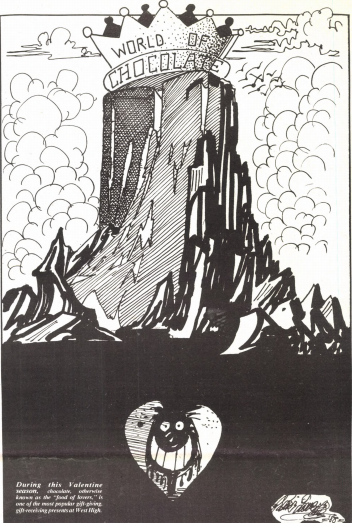Looking back: Addicted to chocolate
This Throwback Thursday, WSS Intern Camille Gretter pulls an article from the 80s about teenagers addiction to chocolate.

Camille Gretter ’23 brings back an article on chocolate consumption so you can enjoy a sweet treat guilt-free.
“Addicted to chocolate” by Pamella Bhalla February 13, 1987
Are you a chocoholic? Do you experience cravings for chocolate on a regular basis? If so, take this opportunity to add yourself to the ever increasing list of Americans who are chocolate lovers.
Americans love chocolate so much that they will spend nearly $4 billion on an approximate two billion pounds of it a year. That is an average of 10 pounds of chocolate per person! Most chocoholics suffer from what can only be called, “chocolate covered guilt,” the worry of getting fat, developing cavities, and breaking out in pimples.
If you share these same worries, relax. Recent studies have concluded that in reasonable quantities, chocolate may not be so bad for your after all.
It has been proven that chocolate has small amounts of protein, iron, riboflavin and calcium. Although chocolate is not a substitute for steak or potatoes, it is not as harmful as some people may believe. As a matter of fact, in some ways milk chocolate, which has more protein and calcium than any other type of chocolate, is more nutritious than an apple. The U.S. Department of Agriculture has shown that compared to a medium-size apple (five ounces), a typical plain milk chocolate bar (1.5 ounces) has 11 times more protein, 10 times more calcium, 7 times more phosphorus, 5 times more riboflavin and 8 percent more potassium, all of which are essential nutrients.
The myth of chocolate causing acne has been around since the late 19th century. According to a recent study done at the University of Pennsylvania, chocolate does not cause or even aggravate acne. Historically, the main purchasers of candy bars were youngsters experiencing adolescence, a prime time when acne develops. A few years ago, the FDA announced that acne is not diet related, but is most likely caused by hormonal changes which occur during puberty.
Not only does chocolate not melt in your hands, it also melts in your mouth without causing tooth decay. According to the American Dental Association, researchers have identified a chemical substance within chocolate which seems to actually reduce the cavity causing properties of the chocolate content. These chemical substances in cocoa actually inhibit the bacterial action which ultimately cause cavities and plaque.
The amount of caffeine, a known stimulant, in a one-ounce bar of chocolate contains five to seven milligrams. In contrast, five ounces of coffee has between 90 and 150 milligrams. Many people find this small amount of caffeine quite stimulating. As Mary Kern ’89, said, “When I’m depressed, chocolate acts as a pick me up, and when I’m happy I figure, why not eat more chocolate and be hyper?”
As the holiday of St. Valentine’s Day fastly approaches, we may find the vast majority of people who do enjoy the most popular gift-giving, gift-recieving present (chocolate) sitting back and savoring it’s taste. According to well-known Iowa City chocolate selling shops, the overall sale of chocolate during the month of February has skyrocketed in the last few years. For example, last year Piper’s Candy, located in the downtown area, experienced such a large demand for packed chocolate packages, that they ran out half-way through the month. As for Sweets and Treats, another well-known candy shop in Iowa City, prides itself on its unique selection of chocolate items.
Chocolate has always been known as the “food of lovers.” As Shelly Costolo ’88 said, “It signifies to someone that they are sweet.” But the main reason chocolate is associated with love may be somewhat surprising. According to researchers, when a person is in love, their brain produces a substance called phenylethylamine, which gives you a natural high. Ironically, chocolate packs loads of the same substance within its own contents.
So, in the unfortunate event that you fall out of love, don’t be at all surprised if you find yourself craving chocolate; afterall, what you’re really doing is replenishing your supply of phenylethylamine.
Reflecting on West High’s addiction to chocolate
Holidays in America are most times something to celebrate and give thanks. One holiday, though, is either highly-anticipated or completely dreaded. That day would be Feb. 14, Valentine’s Day. For all of the happy couples, this is the day roses are bought, and gifts are exchanged. For singles, this day is not as fun and romantic. That’s why I chose an article about chocolate.
Boxes of chocolate, roses, and teddy bears are very common gifts for someone’s significant other on Valentine’s Day. At West High, many students are in relationships, and many are not. But no matter what your relationship status is, chocolate is enjoyed by numerous people.
So say teenagers want to get chocolate but are worried about acne and oily skin. No need to fret, as the original article proves, chocolate does not contribute to pimples and bad skin. Also, with chocolate not causing teeth decay, it doesn’t seem like too bad of a snack, as long as you don’t eat so much that you get sick.
With the little bit of caffeine it gives you, this a way better option than grabbing an energy drink or coffee to get you feeling energized. Chocolate is overall a great candy to celebrate with, and a way to eat candy without stressing about your next dentist appointment or how many pimples you might have the next morning. Couples enjoy it, singles enjoy it, which makes it the number one candy of Valentine’s Day.
Your donation will support the student journalists of West High School. Your contribution will allow us to purchase Scholarship Yearbooks, newsroom equipment and cover our annual website hosting costs.

(she/her) Camille Gretter is a senior at West High and this is her third year on staff. She is the Online Editor-in-Chief, and outside of West Side Story...


